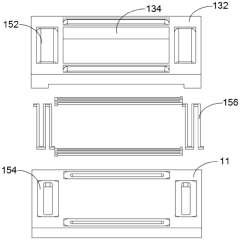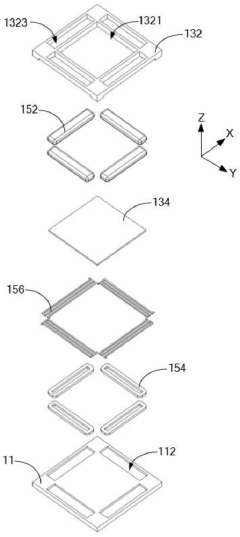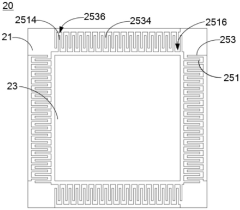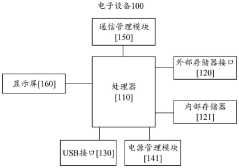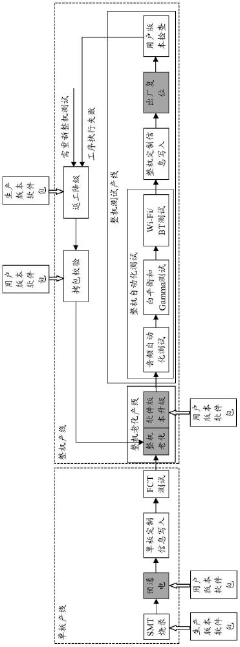How to Enhance ULED Performance through Software Updates?
JUN 23, 20259 MIN READ
Generate Your Research Report Instantly with AI Agent
Patsnap Eureka helps you evaluate technical feasibility & market potential.
ULED Tech Evolution
The evolution of ULED (Ultra Light Emitting Diode) technology has been marked by significant advancements in both hardware and software components. Initially, ULED displays were primarily hardware-driven, with improvements focused on panel design, backlight technology, and pixel structure. However, as the technology matured, software updates emerged as a crucial factor in enhancing ULED performance.
The early stages of ULED development concentrated on increasing pixel density and improving color accuracy. Manufacturers invested heavily in refining the physical structure of ULED panels to achieve higher resolutions and wider color gamuts. This phase saw the introduction of quantum dot technology, which significantly enhanced color reproduction and brightness levels.
As hardware capabilities reached new heights, the industry recognized the potential of software optimization to further improve ULED performance. This shift marked a turning point in ULED evolution, with software updates becoming a key driver of innovation. Manufacturers began developing sophisticated algorithms for image processing, color management, and motion handling.
One of the most significant software-driven improvements in ULED technology has been the implementation of advanced local dimming algorithms. These algorithms allow for precise control of backlight zones, enhancing contrast ratios and reducing blooming effects. Through iterative software updates, manufacturers have continually refined these algorithms, resulting in increasingly lifelike picture quality.
Another area where software updates have played a crucial role is in color calibration and management. Advanced color processing algorithms have been developed to optimize color accuracy across different content types and viewing environments. These software-based solutions enable ULED displays to adapt dynamically to varying lighting conditions and content characteristics.
Motion handling has also seen substantial improvements through software updates. Frame interpolation techniques and motion estimation algorithms have been refined to reduce motion blur and judder, resulting in smoother and more natural-looking content playback. These software enhancements have been particularly beneficial for sports and action content.
The integration of artificial intelligence and machine learning algorithms has further accelerated the evolution of ULED technology. AI-powered image processing can analyze and optimize picture quality in real-time, adjusting parameters such as sharpness, noise reduction, and HDR tone mapping based on the content being displayed.
As ULED technology continues to evolve, the focus on software-driven enhancements is expected to intensify. Future developments may include more sophisticated AI algorithms for content recognition and optimization, as well as improved integration with smart home ecosystems. The ability to deliver significant performance improvements through software updates not only extends the lifespan of ULED displays but also ensures that consumers can benefit from the latest advancements without the need for hardware upgrades.
The early stages of ULED development concentrated on increasing pixel density and improving color accuracy. Manufacturers invested heavily in refining the physical structure of ULED panels to achieve higher resolutions and wider color gamuts. This phase saw the introduction of quantum dot technology, which significantly enhanced color reproduction and brightness levels.
As hardware capabilities reached new heights, the industry recognized the potential of software optimization to further improve ULED performance. This shift marked a turning point in ULED evolution, with software updates becoming a key driver of innovation. Manufacturers began developing sophisticated algorithms for image processing, color management, and motion handling.
One of the most significant software-driven improvements in ULED technology has been the implementation of advanced local dimming algorithms. These algorithms allow for precise control of backlight zones, enhancing contrast ratios and reducing blooming effects. Through iterative software updates, manufacturers have continually refined these algorithms, resulting in increasingly lifelike picture quality.
Another area where software updates have played a crucial role is in color calibration and management. Advanced color processing algorithms have been developed to optimize color accuracy across different content types and viewing environments. These software-based solutions enable ULED displays to adapt dynamically to varying lighting conditions and content characteristics.
Motion handling has also seen substantial improvements through software updates. Frame interpolation techniques and motion estimation algorithms have been refined to reduce motion blur and judder, resulting in smoother and more natural-looking content playback. These software enhancements have been particularly beneficial for sports and action content.
The integration of artificial intelligence and machine learning algorithms has further accelerated the evolution of ULED technology. AI-powered image processing can analyze and optimize picture quality in real-time, adjusting parameters such as sharpness, noise reduction, and HDR tone mapping based on the content being displayed.
As ULED technology continues to evolve, the focus on software-driven enhancements is expected to intensify. Future developments may include more sophisticated AI algorithms for content recognition and optimization, as well as improved integration with smart home ecosystems. The ability to deliver significant performance improvements through software updates not only extends the lifespan of ULED displays but also ensures that consumers can benefit from the latest advancements without the need for hardware upgrades.
Market Demand Analysis
The market demand for enhanced ULED (Ultra Light Emitting Diode) performance through software updates has been steadily growing in recent years. This trend is driven by the increasing adoption of ULED technology in various consumer electronics, particularly in high-end televisions and display panels. Consumers are seeking improved picture quality, energy efficiency, and longevity from their ULED devices, creating a significant opportunity for manufacturers to differentiate their products through software-based enhancements.
The global ULED market is expected to experience substantial growth, with a projected compound annual growth rate (CAGR) of over 15% from 2021 to 2026. This growth is primarily fueled by the rising demand for superior display technologies in both residential and commercial sectors. The ability to enhance ULED performance through software updates is becoming a key factor in consumer purchasing decisions, as it offers the promise of extended product lifespan and improved functionality without the need for hardware replacements.
In the consumer electronics segment, there is a strong demand for ULED televisions that can receive regular software updates to improve picture quality, color accuracy, and contrast ratios. This demand is particularly evident in regions with high disposable incomes, such as North America, Western Europe, and parts of Asia-Pacific. Consumers are willing to pay premium prices for ULED devices that offer the potential for continuous improvement through software updates.
The commercial sector also presents significant opportunities for ULED technology with software-based enhancements. Digital signage, control room displays, and large-format screens in public spaces are increasingly adopting ULED technology. The ability to remotely update and optimize these displays through software is highly valued by businesses looking to maintain cutting-edge visual experiences for their customers and employees.
Energy efficiency is another crucial factor driving the demand for software-enhanced ULED performance. As global energy consumption concerns grow, consumers and businesses alike are seeking display technologies that can reduce power consumption without compromising on visual quality. Software updates that can optimize power usage while maintaining or improving display performance are highly sought after in the market.
The automotive industry is emerging as a new frontier for ULED technology, with a growing interest in advanced infotainment systems and heads-up displays. The ability to update and enhance these displays through software is becoming a key selling point for high-end vehicles, as it allows manufacturers to offer continuous improvements and new features to their customers post-purchase.
In conclusion, the market demand for enhancing ULED performance through software updates is robust and multifaceted. It spans across various industries and is driven by consumer expectations for continuous improvement, energy efficiency, and extended product lifecycles. As ULED technology continues to evolve, the ability to deliver significant performance enhancements through software updates will likely become a critical factor in market competitiveness and consumer satisfaction.
The global ULED market is expected to experience substantial growth, with a projected compound annual growth rate (CAGR) of over 15% from 2021 to 2026. This growth is primarily fueled by the rising demand for superior display technologies in both residential and commercial sectors. The ability to enhance ULED performance through software updates is becoming a key factor in consumer purchasing decisions, as it offers the promise of extended product lifespan and improved functionality without the need for hardware replacements.
In the consumer electronics segment, there is a strong demand for ULED televisions that can receive regular software updates to improve picture quality, color accuracy, and contrast ratios. This demand is particularly evident in regions with high disposable incomes, such as North America, Western Europe, and parts of Asia-Pacific. Consumers are willing to pay premium prices for ULED devices that offer the potential for continuous improvement through software updates.
The commercial sector also presents significant opportunities for ULED technology with software-based enhancements. Digital signage, control room displays, and large-format screens in public spaces are increasingly adopting ULED technology. The ability to remotely update and optimize these displays through software is highly valued by businesses looking to maintain cutting-edge visual experiences for their customers and employees.
Energy efficiency is another crucial factor driving the demand for software-enhanced ULED performance. As global energy consumption concerns grow, consumers and businesses alike are seeking display technologies that can reduce power consumption without compromising on visual quality. Software updates that can optimize power usage while maintaining or improving display performance are highly sought after in the market.
The automotive industry is emerging as a new frontier for ULED technology, with a growing interest in advanced infotainment systems and heads-up displays. The ability to update and enhance these displays through software is becoming a key selling point for high-end vehicles, as it allows manufacturers to offer continuous improvements and new features to their customers post-purchase.
In conclusion, the market demand for enhancing ULED performance through software updates is robust and multifaceted. It spans across various industries and is driven by consumer expectations for continuous improvement, energy efficiency, and extended product lifecycles. As ULED technology continues to evolve, the ability to deliver significant performance enhancements through software updates will likely become a critical factor in market competitiveness and consumer satisfaction.
ULED Software Challenges
ULED (Ultra Light Emitting Diode) technology has made significant strides in recent years, offering superior display quality and energy efficiency. However, as with any cutting-edge technology, ULED faces several software-related challenges that need to be addressed to fully realize its potential.
One of the primary software challenges for ULED is optimizing the color management system. ULED displays are capable of producing a wider color gamut than traditional LED displays, but this increased range requires more sophisticated color processing algorithms. Developing software that can accurately map and render the expanded color space while maintaining color accuracy across different content types and viewing conditions is a complex task.
Another significant challenge lies in the realm of motion handling and frame rate optimization. ULED displays often boast higher refresh rates, which can lead to smoother motion. However, this also requires advanced motion interpolation algorithms to prevent artifacts such as judder or the "soap opera effect." Balancing the benefits of high refresh rates with natural-looking motion is a delicate software challenge that requires continuous refinement.
Power management presents another critical software hurdle for ULED technology. While ULED is inherently more energy-efficient than traditional LED, there is still room for improvement through intelligent software control. Developing algorithms that can dynamically adjust brightness and contrast based on ambient light conditions and content type, without compromising picture quality, is an ongoing challenge.
The integration of AI and machine learning capabilities into ULED software systems presents both opportunities and challenges. These technologies can potentially enhance image processing, automate calibration, and improve overall display performance. However, implementing these features in a way that is computationally efficient and doesn't introduce latency is a significant software engineering challenge.
Lastly, ensuring software compatibility and updatability across different ULED models and generations is a persistent challenge. As ULED technology evolves, software must be designed with flexibility and scalability in mind to accommodate future hardware improvements and new features. This requires a robust software architecture that can adapt to changing hardware specifications while maintaining backward compatibility.
Addressing these software challenges is crucial for enhancing ULED performance through updates. It requires a multidisciplinary approach, combining expertise in image processing, color science, power management, and AI. As the technology continues to mature, overcoming these software hurdles will be key to unlocking the full potential of ULED displays and maintaining their competitive edge in the market.
One of the primary software challenges for ULED is optimizing the color management system. ULED displays are capable of producing a wider color gamut than traditional LED displays, but this increased range requires more sophisticated color processing algorithms. Developing software that can accurately map and render the expanded color space while maintaining color accuracy across different content types and viewing conditions is a complex task.
Another significant challenge lies in the realm of motion handling and frame rate optimization. ULED displays often boast higher refresh rates, which can lead to smoother motion. However, this also requires advanced motion interpolation algorithms to prevent artifacts such as judder or the "soap opera effect." Balancing the benefits of high refresh rates with natural-looking motion is a delicate software challenge that requires continuous refinement.
Power management presents another critical software hurdle for ULED technology. While ULED is inherently more energy-efficient than traditional LED, there is still room for improvement through intelligent software control. Developing algorithms that can dynamically adjust brightness and contrast based on ambient light conditions and content type, without compromising picture quality, is an ongoing challenge.
The integration of AI and machine learning capabilities into ULED software systems presents both opportunities and challenges. These technologies can potentially enhance image processing, automate calibration, and improve overall display performance. However, implementing these features in a way that is computationally efficient and doesn't introduce latency is a significant software engineering challenge.
Lastly, ensuring software compatibility and updatability across different ULED models and generations is a persistent challenge. As ULED technology evolves, software must be designed with flexibility and scalability in mind to accommodate future hardware improvements and new features. This requires a robust software architecture that can adapt to changing hardware specifications while maintaining backward compatibility.
Addressing these software challenges is crucial for enhancing ULED performance through updates. It requires a multidisciplinary approach, combining expertise in image processing, color science, power management, and AI. As the technology continues to mature, overcoming these software hurdles will be key to unlocking the full potential of ULED displays and maintaining their competitive edge in the market.
Current Software Solutions
01 ULED display panel structure
ULED display panels incorporate advanced structures to enhance performance. These may include specialized pixel arrangements, improved light-emitting layers, and optimized electrode configurations. Such structural innovations contribute to better color reproduction, higher brightness, and increased energy efficiency in ULED displays.- ULED display structure and manufacturing: ULED (Ultra Light Emitting Diode) displays involve advanced structures and manufacturing processes to enhance performance. This includes innovations in pixel arrangements, substrate materials, and fabrication techniques to improve brightness, contrast, and energy efficiency. The manufacturing process may involve precise deposition of organic materials and the integration of thin-film transistors for active matrix control.
- ULED backlight technology: ULED backlight technology focuses on improving the performance of LCD displays by using ultra-thin LED arrays. This approach allows for local dimming, enhanced contrast ratios, and improved color accuracy. The backlight units may incorporate advanced optical films and light guide plates to optimize light distribution and reduce power consumption.
- ULED color management and image processing: Color management and image processing techniques are crucial for ULED performance. This includes algorithms for dynamic contrast adjustment, color gamut expansion, and HDR (High Dynamic Range) processing. Advanced image processors may be employed to enhance picture quality, reduce motion blur, and optimize content for ULED displays.
- ULED power efficiency and thermal management: Improving power efficiency and thermal management is essential for ULED performance. This involves developing low-power driving circuits, implementing intelligent power-saving modes, and designing effective heat dissipation solutions. Thermal management strategies may include the use of advanced materials and innovative cooling systems to maintain optimal operating temperatures.
- ULED quantum dot technology integration: The integration of quantum dot technology with ULED displays aims to enhance color performance and energy efficiency. Quantum dots can be used to improve color purity, expand the color gamut, and increase the overall brightness of ULED displays. This technology may involve the development of new quantum dot materials and their incorporation into ULED structures.
02 Driving method for ULED displays
Innovative driving methods are employed to improve ULED performance. These techniques may involve advanced voltage control, current regulation, and timing algorithms. By optimizing the driving scheme, ULED displays can achieve better uniformity, reduced power consumption, and enhanced overall visual quality.Expand Specific Solutions03 Thermal management in ULED devices
Effective thermal management is crucial for maintaining ULED performance. This involves implementing heat dissipation structures, using thermally conductive materials, and designing efficient cooling systems. Proper thermal management helps prevent performance degradation, extends device lifespan, and ensures consistent output quality.Expand Specific Solutions04 ULED backlight technology
ULED backlight technology focuses on improving display performance through advanced light source designs. This may include optimized LED arrangements, light guide plates, and optical films. Enhanced backlight systems contribute to better contrast, color accuracy, and energy efficiency in ULED displays.Expand Specific Solutions05 ULED color management and calibration
Color management and calibration techniques are essential for optimizing ULED performance. These methods may involve advanced color processing algorithms, real-time adjustment systems, and precise calibration procedures. Implementing effective color management ensures accurate color reproduction, consistency across displays, and improved overall image quality.Expand Specific Solutions
Key ULED Manufacturers
The ULED (Ultra Light-Emitting Diode) technology market is in a growth phase, with increasing demand for high-performance displays across various industries. The market size is expanding rapidly, driven by applications in consumer electronics, automotive, and commercial sectors. Technologically, ULED is maturing, with companies like BOE Technology Group, Samsung Electronics, and Hisense Visual Technology leading innovation. These firms are focusing on software-based enhancements to improve ULED performance, indicating a shift towards more sophisticated, software-driven solutions. Emerging players like Shenzhen Yinwang Intelligent Technology and ZTE Corp are also contributing to the competitive landscape, pushing for advancements in software optimization to enhance ULED capabilities and efficiency.
BOE Technology Group Co., Ltd.
Technical Solution: BOE has developed a comprehensive software update system for ULED displays. Their approach includes over-the-air (OTA) updates, which allow for remote firmware upgrades and feature enhancements. The system incorporates adaptive algorithms that optimize display parameters based on ambient light conditions and content type. BOE's software also includes advanced color management tools that can fine-tune color accuracy and consistency across different ULED panels.
Strengths: Wide-ranging update capabilities, adaptive optimization, and color management. Weaknesses: May require significant processing power, potentially increasing costs.
Samsung Electronics Co., Ltd.
Technical Solution: Samsung's approach to enhancing ULED performance through software updates focuses on their Tizen operating system. They have implemented a modular software architecture that allows for targeted updates to specific display components. Their system includes AI-driven picture quality enhancement algorithms that can be continuously improved through machine learning. Samsung also incorporates user behavior analysis to tailor display settings to individual preferences over time.
Strengths: AI-driven enhancements, personalized optimization, and modular architecture. Weaknesses: Dependency on proprietary Tizen OS may limit compatibility with some third-party applications.
Core ULED SW Innovations
ULED packaging structure and imaging device
PatentPendingCN116741909A
Innovation
- By introducing a drive reset component into the uLED packaging structure, the drive frame moves in the second direction relative to the substrate to provide a reset force, using the persistence of vision of the human eye to reduce the impact of unlit uLEDs, stabilize imaging quality, and achieve a compact structure. change.
Software version upgrade method and electronic equipment
PatentActiveCN116028100B
Innovation
- Copy the user version of the software package in the single board production line, upgrade the software version in the aging production line of the whole machine, and then perform a factory reset on the whole machine test production line to shorten the time of the whole machine test production line and improve the line efficiency.
ULED Hardware Integration
ULED (Ultra Light Emitting Diode) technology has revolutionized display systems, offering superior brightness, contrast, and energy efficiency. The integration of ULED hardware components is crucial for maximizing the potential of software updates to enhance overall performance.
At the core of ULED hardware integration is the advanced LED chip design. These chips are engineered with precision to emit light at specific wavelengths, resulting in more vibrant and accurate color reproduction. The integration process involves carefully mounting these chips onto a substrate, ensuring optimal thermal management and electrical connectivity.
The driver circuitry plays a pivotal role in ULED hardware integration. It controls the current flow to each LED, enabling precise dimming and color control. Advanced driver designs incorporate features like pulse-width modulation (PWM) and constant current regulation, which are essential for software-based performance enhancements.
Thermal management is another critical aspect of ULED hardware integration. High-performance LEDs generate significant heat, which can affect both lifespan and color accuracy. Integrating efficient heat sinks and thermal dissipation pathways into the hardware design is crucial for maintaining optimal performance over time and allowing software updates to push the system to its full potential.
Optical components, such as lenses and diffusers, are integrated to shape and direct the light output. These elements are carefully selected and positioned to achieve the desired viewing angle, uniformity, and brightness distribution. The integration of these optical components must be precise to ensure that software-driven improvements in image quality and brightness are fully realized.
Color management hardware, including color sensors and calibration systems, is integrated to enable accurate color reproduction and consistency across the display. These components work in tandem with software algorithms to maintain color accuracy over time and adapt to changing environmental conditions.
The integration of connectivity interfaces is essential for enabling software updates and real-time performance adjustments. This includes implementing robust communication protocols and secure update mechanisms to ensure that performance enhancements can be safely and efficiently deployed to the ULED system.
Power management circuitry is integrated to optimize energy consumption and enable dynamic power adjustments based on content and ambient conditions. This integration allows software updates to fine-tune power usage, balancing performance with energy efficiency.
Finally, the integration of diagnostic and monitoring hardware enables real-time performance tracking and fault detection. These components provide valuable data that can be leveraged by software updates to optimize performance and implement predictive maintenance strategies.
At the core of ULED hardware integration is the advanced LED chip design. These chips are engineered with precision to emit light at specific wavelengths, resulting in more vibrant and accurate color reproduction. The integration process involves carefully mounting these chips onto a substrate, ensuring optimal thermal management and electrical connectivity.
The driver circuitry plays a pivotal role in ULED hardware integration. It controls the current flow to each LED, enabling precise dimming and color control. Advanced driver designs incorporate features like pulse-width modulation (PWM) and constant current regulation, which are essential for software-based performance enhancements.
Thermal management is another critical aspect of ULED hardware integration. High-performance LEDs generate significant heat, which can affect both lifespan and color accuracy. Integrating efficient heat sinks and thermal dissipation pathways into the hardware design is crucial for maintaining optimal performance over time and allowing software updates to push the system to its full potential.
Optical components, such as lenses and diffusers, are integrated to shape and direct the light output. These elements are carefully selected and positioned to achieve the desired viewing angle, uniformity, and brightness distribution. The integration of these optical components must be precise to ensure that software-driven improvements in image quality and brightness are fully realized.
Color management hardware, including color sensors and calibration systems, is integrated to enable accurate color reproduction and consistency across the display. These components work in tandem with software algorithms to maintain color accuracy over time and adapt to changing environmental conditions.
The integration of connectivity interfaces is essential for enabling software updates and real-time performance adjustments. This includes implementing robust communication protocols and secure update mechanisms to ensure that performance enhancements can be safely and efficiently deployed to the ULED system.
Power management circuitry is integrated to optimize energy consumption and enable dynamic power adjustments based on content and ambient conditions. This integration allows software updates to fine-tune power usage, balancing performance with energy efficiency.
Finally, the integration of diagnostic and monitoring hardware enables real-time performance tracking and fault detection. These components provide valuable data that can be leveraged by software updates to optimize performance and implement predictive maintenance strategies.
User Experience Impact
Software updates play a crucial role in enhancing ULED (Ultra Light Emitting Diode) performance, significantly impacting user experience. These updates can dramatically improve display quality, energy efficiency, and overall device functionality, leading to increased user satisfaction and engagement.
One of the primary ways software updates enhance ULED performance is through improved color calibration and management. By fine-tuning the color gamut and implementing advanced color processing algorithms, updates can deliver more accurate and vibrant colors, resulting in a more immersive viewing experience. This is particularly noticeable in high-dynamic-range (HDR) content, where the enhanced color reproduction can make images appear more lifelike and captivating.
Brightness control is another area where software updates can greatly impact user experience. By implementing sophisticated adaptive brightness algorithms, ULED displays can automatically adjust their luminance based on ambient lighting conditions. This not only enhances visibility in various environments but also reduces eye strain during prolonged use, contributing to improved user comfort and well-being.
Motion handling is a critical aspect of display performance that can be significantly enhanced through software updates. By implementing advanced motion interpolation techniques and reducing input lag, updates can deliver smoother and more responsive visuals. This improvement is particularly noticeable in fast-paced content such as sports broadcasts or action-packed video games, where fluid motion can greatly enhance the viewing experience.
Energy efficiency is another key area where software updates can positively impact user experience. By optimizing power management algorithms, updates can extend battery life in portable devices or reduce power consumption in larger displays. This not only contributes to sustainability efforts but also allows users to enjoy their devices for longer periods without interruption.
Software updates can also introduce new features and functionalities that directly enhance the user experience. For example, updates might enable picture-in-picture capabilities, implement advanced upscaling algorithms for lower-resolution content, or introduce customizable display modes tailored to specific content types or user preferences. These additions can significantly expand the versatility and usability of ULED-equipped devices.
Lastly, software updates can address and resolve various display-related issues that may negatively impact user experience. By fixing bugs, eliminating screen flickering, or reducing image retention, updates can ensure a more stable and reliable display performance. This ongoing refinement process helps maintain user satisfaction over the long term and can even breathe new life into older devices, extending their usable lifespan.
One of the primary ways software updates enhance ULED performance is through improved color calibration and management. By fine-tuning the color gamut and implementing advanced color processing algorithms, updates can deliver more accurate and vibrant colors, resulting in a more immersive viewing experience. This is particularly noticeable in high-dynamic-range (HDR) content, where the enhanced color reproduction can make images appear more lifelike and captivating.
Brightness control is another area where software updates can greatly impact user experience. By implementing sophisticated adaptive brightness algorithms, ULED displays can automatically adjust their luminance based on ambient lighting conditions. This not only enhances visibility in various environments but also reduces eye strain during prolonged use, contributing to improved user comfort and well-being.
Motion handling is a critical aspect of display performance that can be significantly enhanced through software updates. By implementing advanced motion interpolation techniques and reducing input lag, updates can deliver smoother and more responsive visuals. This improvement is particularly noticeable in fast-paced content such as sports broadcasts or action-packed video games, where fluid motion can greatly enhance the viewing experience.
Energy efficiency is another key area where software updates can positively impact user experience. By optimizing power management algorithms, updates can extend battery life in portable devices or reduce power consumption in larger displays. This not only contributes to sustainability efforts but also allows users to enjoy their devices for longer periods without interruption.
Software updates can also introduce new features and functionalities that directly enhance the user experience. For example, updates might enable picture-in-picture capabilities, implement advanced upscaling algorithms for lower-resolution content, or introduce customizable display modes tailored to specific content types or user preferences. These additions can significantly expand the versatility and usability of ULED-equipped devices.
Lastly, software updates can address and resolve various display-related issues that may negatively impact user experience. By fixing bugs, eliminating screen flickering, or reducing image retention, updates can ensure a more stable and reliable display performance. This ongoing refinement process helps maintain user satisfaction over the long term and can even breathe new life into older devices, extending their usable lifespan.
Unlock deeper insights with Patsnap Eureka Quick Research — get a full tech report to explore trends and direct your research. Try now!
Generate Your Research Report Instantly with AI Agent
Supercharge your innovation with Patsnap Eureka AI Agent Platform!

